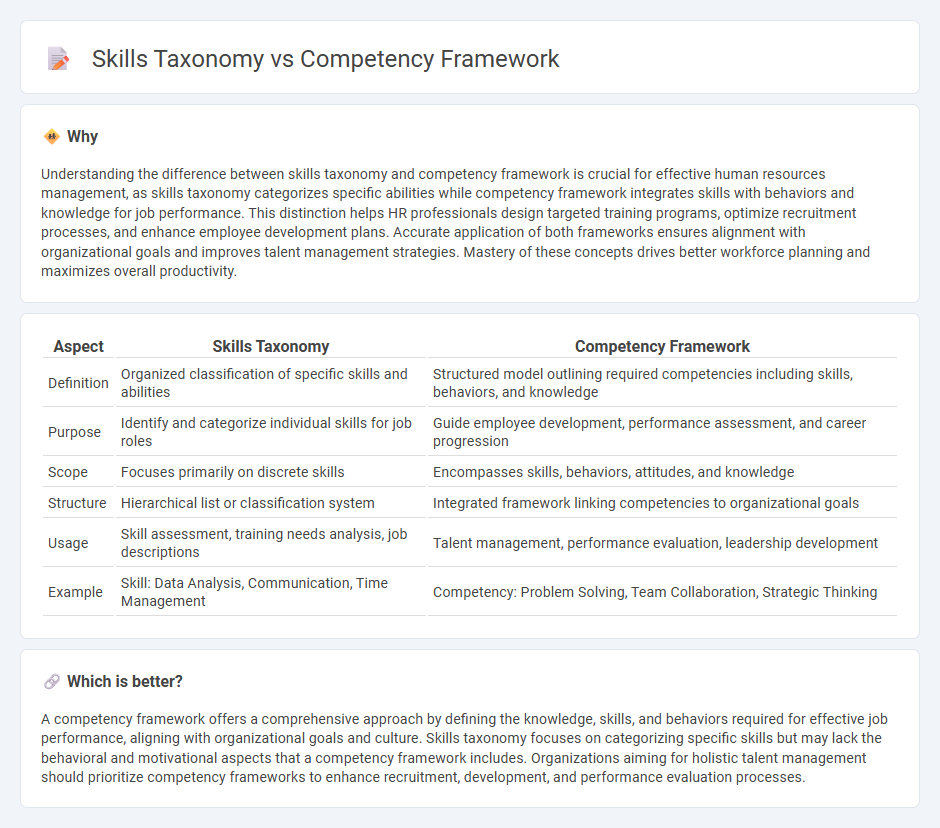
Skills taxonomy organizes individual capabilities into a structured hierarchy, enabling precise identification and development of specific abilities within an organization. Competency frameworks encompass broader behavioral attributes and performance criteria, aligning employee skills with organizational goals and culture. Explore the differences to enhance your talent management strategies effectively.
Why it is important
Understanding the difference between skills taxonomy and competency framework is crucial for effective human resources management, as skills taxonomy categorizes specific abilities while competency framework integrates skills with behaviors and knowledge for job performance. This distinction helps HR professionals design targeted training programs, optimize recruitment processes, and enhance employee development plans. Accurate application of both frameworks ensures alignment with organizational goals and improves talent management strategies. Mastery of these concepts drives better workforce planning and maximizes overall productivity.
Comparison Table
| Aspect | Skills Taxonomy | Competency Framework |
|---|---|---|
| Definition | Organized classification of specific skills and abilities | Structured model outlining required competencies including skills, behaviors, and knowledge |
| Purpose | Identify and categorize individual skills for job roles | Guide employee development, performance assessment, and career progression |
| Scope | Focuses primarily on discrete skills | Encompasses skills, behaviors, attitudes, and knowledge |
| Structure | Hierarchical list or classification system | Integrated framework linking competencies to organizational goals |
| Usage | Skill assessment, training needs analysis, job descriptions | Talent management, performance evaluation, leadership development |
| Example | Skill: Data Analysis, Communication, Time Management | Competency: Problem Solving, Team Collaboration, Strategic Thinking |
Which is better?
A competency framework offers a comprehensive approach by defining the knowledge, skills, and behaviors required for effective job performance, aligning with organizational goals and culture. Skills taxonomy focuses on categorizing specific skills but may lack the behavioral and motivational aspects that a competency framework includes. Organizations aiming for holistic talent management should prioritize competency frameworks to enhance recruitment, development, and performance evaluation processes.
Connection
Skills taxonomy organizes and categorizes specific abilities and knowledge areas within an organization, providing a structured inventory of employee capabilities. Competency frameworks align these skills with job roles and performance standards, defining the behaviors and attributes required for success. Together, they enable targeted talent management, workforce development, and strategic HR planning by linking skill identification to practical competency application.
Key Terms
**Competency Framework:**
A competency framework defines a structured collection of behaviors, knowledge, and abilities essential for successful job performance, emphasizing alignment with organizational goals and culture. It integrates both technical and soft skills to guide recruitment, development, and performance management processes. Explore how a competency framework enhances workforce capability and strategic growth.
Behaviors
Competency frameworks emphasize behaviors by defining the observable actions and attitudes that reflect effective performance within a role or organization. Skills taxonomies categorize and organize specific technical or functional skills without necessarily detailing the behavioral aspects tied to their application. Explore how integrating behavioral insights into your talent development strategy can enhance employee performance and organizational culture.
Performance standards
A competency framework defines the performance standards required to achieve consistent excellence across specific roles by outlining observable behaviors, knowledge, and abilities tied to job success. Skills taxonomy categorizes and organizes skills hierarchically but does not inherently establish performance benchmarks or measurable standards. Explore more about how integrating these models can enhance talent development and assessment strategies.
Source and External Links
The competency framework by IAEA - A competency framework broadly describes performance excellence within an organization by defining required behaviors, core values, and competencies applied across roles to ensure consistent understanding of values and performance standards.
What Is a Competency Model? Expert Guidance on Developing Yours - A competency model is a structured framework defining the skills, knowledge, and behaviors needed for success in a role, developed through steps including goal definition, research, and listing core, job-specific, and leadership competencies.
How to Create a Comprehensive Competency Model From Scratch - This guide explains how to build a competency matrix mapping required competencies to roles, write clear and actionable competencies, and use the model for performance appraisals and workforce development planning.
 dowidth.com
dowidth.com